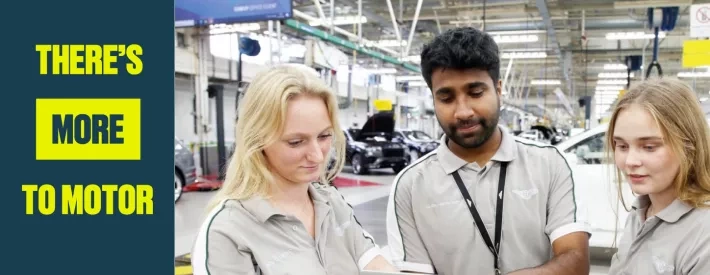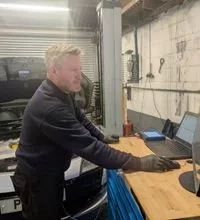Come in – we have vacancies

We have a problem. Some might say it’s a big problem. The automotive industry is struggling to recruit the number of people needed to maintain the sector, especially as new technologies come online and a greater range of skills are required.
According the latest IMI research, we are now in the unenviable position of being joint top of the charts for job vacancies, sitting beside the accommodation and food service sector, with 4.1 vacancies for every 100 employees. ONS analysis paints a similarly stark picture. There are many reasons to remain positive about the sector, but why is the challenge to attract people into the industry so great and seemingly not improving?
“The sector has faced a rising vacancy rate since 2021, but what is making the environment even more challenging for employees is the need for more advanced technological skills,” says Emma Carrigy, Research Manager at the IMI. “The result is that automotive is going head to head with other tech-led sectors, yet there are deep-seated misconceptions about the career opportunities on offer.”
Vacancies in the automotive aftermarket currently stand at around 23,000, a figure
that has remained stubbornly high for around 12 months. The available roles span the entire industry and include every position you can imagine, especially technical roles – even light vehicle technicians.
A perfect storm
One of the reasons automotive has found it difficult to fill jobs is a perfect storm of politics, the pandemic and the economy. Leaving the European Union had a huge impact on the number of people leaving the industry, which, when combined with the COVID pandemic, hit the sector hard. In simple terms, those events pushed attrition rates up.
Brexit was the precursor for many non-UK workers to leave the industry, while COVID acted as a catalyst for even more people to exit.
“First we had the big resignation, then we had the early retirement phenomenon, which led to post-COVID attrition rates going sky-high all over the country,” says Carrigy. “In 2022, we were up to 12.7% compared to non-automotive, which was around 12%. The following year, it dropped down to 10.9% in automotive and we
are now lower than non-automotive, but our vacancy rate remains really high.”
The IMI has invested a great deal of time and energy into researching the causes of
high attrition rates as part of its latest sector report. Titled ‘Driving towards inclusion’,
the report states: ‘Recent years have seen a significant phenomenon known as the ‘Great Attrition’. This global workforce shift has profound implications for the UK automotive sector, with 55% of automotive employers reporting it more difficult to keep staff than before the pandemic.
‘Attrition rates are a clear reflection of an organisation’s pulse,’ it continues. ‘These rates, showing the proportion of employees who leave within a given period, are vital for gauging the stability of a workforce, company or sector. At their core, attrition rates are the litmus test for employee contentment and the success of an organisational culture.
‘While high rates may ring alarm bells, signalling deep-seated issues within the company framework, low rates can be indicative of a harmonious and engaging work environment. With reports that around half of companies have difficulty in recruiting new workers, and that one in five are struggling to retain staff, understanding the drivers of attrition are more important than ever.
‘One cause is a tightening job market, coupled with stagnating wages, which sets a challenging backdrop that can erode employee loyalty and spur attrition. In 2023, a report by the Financial Times revealed that downsizing by 1% can lead to a 31% increase in voluntary staff turnover the following year.’
However, high attrition isn’t just about finances. Equality, diversity and inclusion (EDI) are important drivers in either keeping or losing staff. In sectors such as automotive, which are reliant on skilled workers, companies need to reassess employee engagement and value recognition strategies if they want to keep their positions filled.
Reversing the trend
The fact that attrition rates are improving is positive news. “The data indicates that
internal churn has actually calmed down,” says Carrigy. The issue is that while attrition figures drop, vacancy numbers remain high because automotive simply doesn’t have enough people coming in. But change is possible.
“The IMI’s ‘There’s More to Motor’ campaign is working hard to change perceptions and encourage a broader range of jobseekers to consider a career in automotive,” she continues. “With support from employers, this campaign is critical as the mix of automotive technologies on UK roads – from fossil fuel and electric vehicles to the latest advanced driver-assistance systems – demands a more diverse skill set than ever before.”
Focused on improving perceptions of the automotive industry and encouraging individuals to consider a career in the sector, the highly targeted campaign utilises engaging creative, including video case studies, to debunk stereotypes that surround many automotive professions.
As a result, the first phase of the campaign has achieved over five million impressions and 35,000 conversions in its first phase, exceeding expectation across all platforms, with planning for phase two is locked in.
“Not only did we achieve our objective of making significant inroads to changing perceptions of the automotive sector, but we surpassed industry benchmarks with our innovative campaign and achieved impressive results across multiple platforms,” says Sally Hodder, Head of Equity, Diversity, Inclusion and Belonging at the IMI. “Our most valuable conversion goal was to get users clicking through to partner sites where they can browse and apply for job opportunities. We saw more than 2,000 conversions for this, proving how relevant the ads were for the audience. The campaign has certainly raised awareness for jobs across the automotive sector. However, there is still much to do in continuing to raise awareness and improving the overall impression of the jobs available in automotive so that we can continue to fill the growing skills gaps across the industry.”
Get involved!
There is an urgent need to encourage more people to think about a career in automotive, with IMI data suggesting that 111,400 roles need to be filled in the next 10 years. There are currently 218 occupations across the sector, with technological advances from ADAS and electric to connected motoring and online sales creating opportunities that go far beyond the traditional perceptions of automotive.
The key to continued long-term success and driving down the vacancy rates is greater industry engagement and support for campaigns such as There’s More to Motor. The industry needs to come together to spread the word, improve perceptions and encourage talented individuals to consider a long and rewarding career in the sector. By doing that, we will make the industry more attractive to everyone and soon lose the unenviable top spot for the highest vacancy rate.
Find out more about the IMI’s There’s More to Motor campaign
This is an edited extract from IMI's new MotorPro magazine, received free as part of IMI membership.




